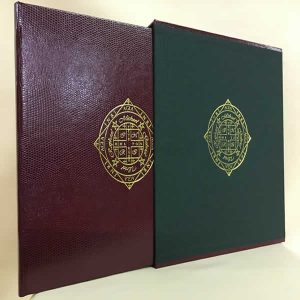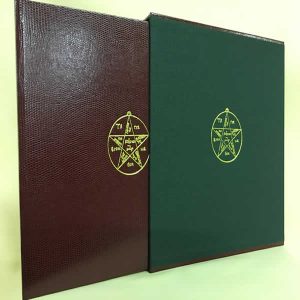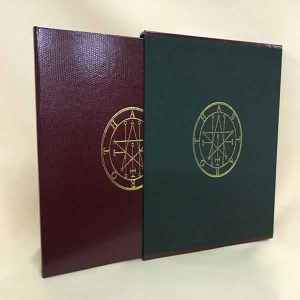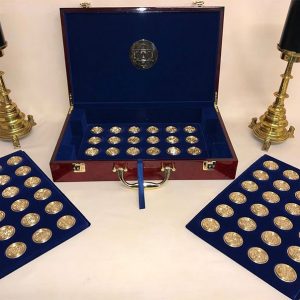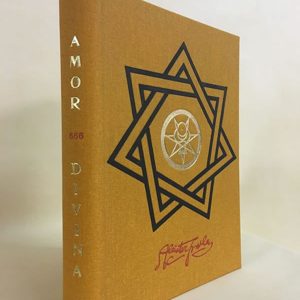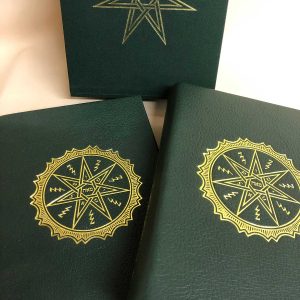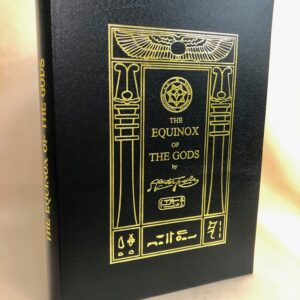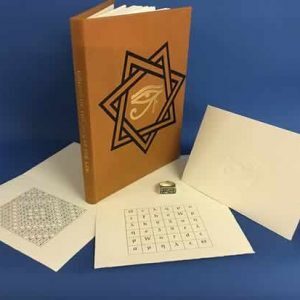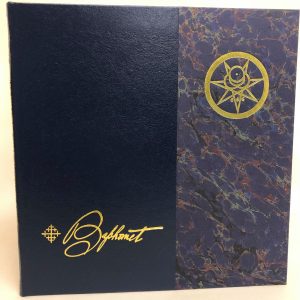ENOCHIANA
Volume 1: Parts 1 & 2
being
‘The Life of John Dee’
&
‘The Private Diary of John Dee with a
Catalogue of his Manuscripts’

Two volume box set
Over 200 pages
Limited to 150 hand numbered sets
‘O comfortable allurement, O ravishing persuasion to deal with a science whose subject is so ancient, so pure, so excellent, so surrounding all creatures, so used of the almighty and incomprehensible wisdom of the Creator, in distinct creation of all creatures: in all their distinct parts, properties, natures, and virtues, by order, and most absolute number, brought from nothing to the formality of their being and state.’ John Dee : Euclids Elements 1570
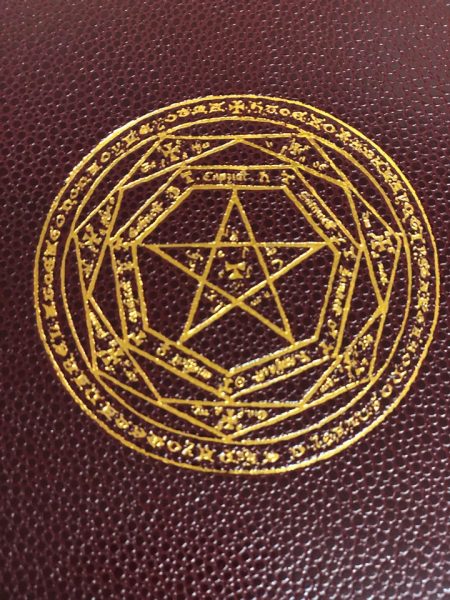
The ‘Seal of Truth’ stamped in copper to the front of each volume
‘It is by the straight line and the circle that the
representation of all things may be demonstrated’
John Dee: ‘Monas Hieroglyphica’ 1584

Both volumes copper stamped with the ‘Seal of Truth’ with the
slipcase stamped with a design of the Monas Hieroglyphica

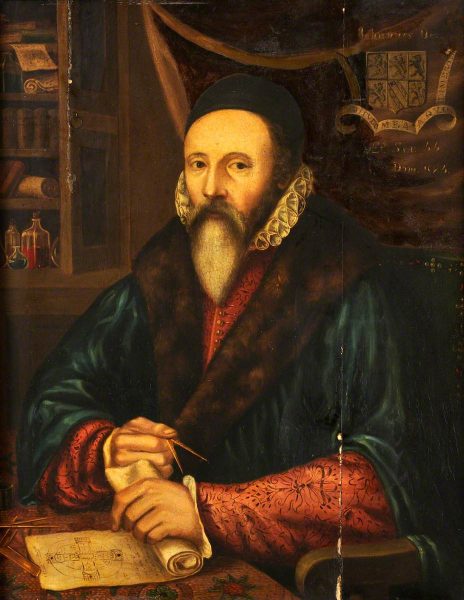
Portrait of John Dee with an angelical scroll showing the plan
for his golden plate of the ‘Four Castles’ or Watchtowers

‘The Four Castles’ or Watchtowers of the Universe
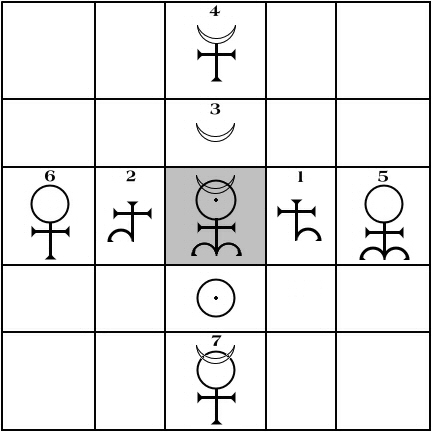
Permutations of Dee’s ‘Monas Hieroglyphica’
The immense figure of John Dee towers above the horizon in any view of the occult sciences, in these two volumes we have an important early biography presented by the eminent scholar Reverend Alexander Ayton (a principal figure in the founding of the Hermetic Order of the Golden Dawn), and the ‘Private Diary’: information preserved in marginal notes to Dees own books which were preserved at the Bodleian Library and published by James Orchard Halliwell in 1842.
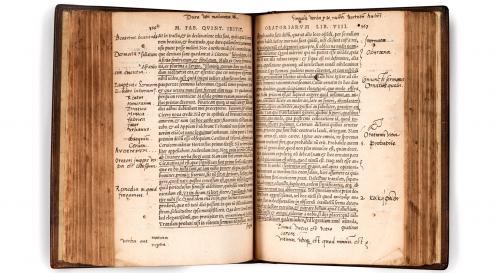
One of Dee’s annotated books now at the
Royal College of Physicians London
Early Life: The Dee family was Welsh and there exist three pedigrees, two of which are heavily annotated by John Dee and are perhaps based on information supplied to him by his cousin Lewis ap Howell Dee in 1567. There he describes his father as ‘antesignanus dapiferorum’ (‘chief sewer’) to Henry VIII. Rowland Dee was later a merchant and was admitted to the Mercers’ Company of London in 1536. He does not seem to have been a prominent member of the company, and apart from the fact that he was excluded from the pardon issued to those who had taken part in Wyatt’s rebellion in 1554 (but was later none the less pardoned), little is known of him; his son does not record his death. The pedigrees, which trace Dee’s ancestry through the Lord Rhys (Rhys ap Gruffudd) to Rhodri Mawr and Coel Hen, are unlikely to be accurate for more than three or four generations back. His mother owned houses and land in Mortlake which were surrendered to her son in 1579, and it is possible that her family originated there.
Dee was educated at Chelmsford grammar school, and entered St John’s College, Cambridge, in 1542, where he claimed to have studied for up to eighteen hours a day. In 1546 he was elected a fellow and under-reader in Greek at the newly founded Trinity College, and he received his MA in 1548. He is normally styled Doctor Dee, but his only claim to this title seems to be his receiving a doctorate of medicine from the University of Prague in 1584 or 1585. John Chamberlain refers to him as Dr Dee in 1599, and this usage seems to have become accepted after Dee’s death.
The date of Dee’s first marriage, to Katherine, widow of Thomas Constable, a London grocer with whom he had been in some way associated as early as 1558, is unknown but probably took place in 1565 or 1566, after his return from his third continental journey, and his settling at Mortlake. There were no children of this marriage, and Katherine Dee died in 1575; her burial coincided with a visit by the queen to Mortlake. Dee married for a second time, on 5 February 1578; his new wife was Jane Fromond or Fromonds (1555–1605), daughter of Bartholomew Fromonds of Cheam, Surrey. (In Dee’s diary his wife’s name is always Fromonds; elsewhere it appears as Fromond.) There were eight children of this marriage, though only Arthur Dee (1579–1651) and Katherine (b. 1581) seem to have survived their father.
First continental visits, and career to 1558
Dee made his first visit to the continent shortly after his election to Trinity College. His own account of his early travels is contained within the ‘Compendious rehearsal’ which he prepared for the queen’s commissioners in 1592 and revised in 1594. This document, supported by written evidence displayed at the time, was designed to emphasize his services to the state, and, though rhetorical in tone, is accurate in detail. He also made personal entries in printed volumes of ephemerides, though apart from a few entries copied by Elias Ashmole the early volumes have perished. Two volumes, from which J. O. Halliwell published Dee’s notes as his Diary (1842), are Joannes Stadius’s Ephemerides novae ab anno 1554 usque ad annum 1600 (1570) and Joannes Antonius Maginus’s Ephemerides coelestium motuum ad annos XL (1582), both in the Bodleian Library. Dee himself normally followed the practice of these works in reckoning the year as beginning on 1 January. The chronological framework is confirmed by Dee’s notes of ownership in many of his books.
Dee recorded that he visited the Southern Netherlands in May 1547 ‘to speake and conferr with some learned men, and chiefly mathematicians’ (Compendious rehearsal, ed. Hearne, 500–01), whom he names as Gemma Frisius, Gerardus Mercator, Gaspar à Mirica, and Antonio Gogava. He returned to Cambridge after a few months, bearing mathematical instruments designed by Gemma and Mercator which were later presented to the college. His only recorded academic achievement at Trinity was a production of Aristophanes’ Pax in which Trygaeus rode up to the roof of the college hall upon a scarab beetle. This early use of stage machinery caused by his own account ‘great wondring’ and, combined with his interest in the animation of statues and in mechanical toys, contributed to his enduring (though to him highly unwelcome) reputation as a conjuror.
Dee’s return to the Southern Netherlands in the following year may be connected both with his own dissatisfaction with the state of mathematical learning in England and with proposed curricular changes, favouring mathematics, at Cambridge. He may have been sent by a patron: Sir William Pickering proved to be such in 1549. Dee entered the University of Louvain on 24 June 1548, continuing the studies that he had begun in the previous year, which included mathematics, geography, astrology, astronomical observation, and ‘for recreation’ civil law. His presence in both Louvain and Antwerp is attested by inscriptions in his growing library. He left Louvain on 15 July 1550, without receiving any further degree, and five days later arrived in Paris. Rheims College was the scene of his lecturing upon Euclid’s Elements, ‘Mathematicé, Physicé, & Pythagoricé’, to a vast and eager audience. He also relates that he refused the offer of a professorship of mathematics in the University of Paris at a salary of 200 crowns.
Dee returned to England at the end of 1551 and was so well commended to Edward VI by Sir William Cecil and Sir John Cheke that the king granted him an annual pension of 100 crowns, which was commuted into the rectory of Upton upon Severn, Worcestershire, in May 1553, an income which was later augmented with the rectory of Long Leadenham, Lincolnshire. In 1552 he entered into the service of the earl of Pembroke, and later into that of the duke of Northumberland, to whose son, John, earl of Warwick, he seems to have acted as tutor, and of whose aptitude he later spoke with unusual warmth.
With the accession of Queen Mary in 1553 the Dudleys fell from power; Northumberland was executed in 1553, and Warwick died in 1554. Dee then resorted to the teaching of mathematics in London, but declined an invitation in 1554 from Richard Bruern and Richard Smith to read the mathematical sciences at Oxford; notes in his books show that he was in Oxford in April of that year, and may have acquired his first recorded pupil, Christopher Carye, there. He was in London in the following year, and was admitted by patrimony to the Mercers’ Company, thus gaining access to merchants, such as Sir Lionel Duckett and the Loks, who were to make use of his mathematical and navigational skills in trading ventures such as the Russia Company, and in the quest for the north-east and north-west passages.
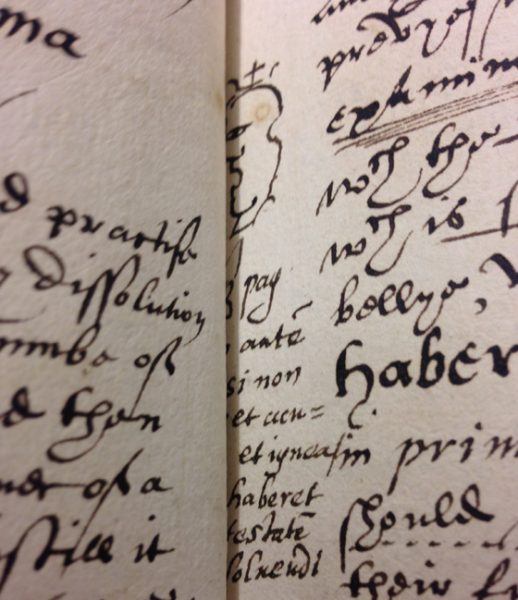
Alchemical manuscript in the hand of John Dee
In May 1555 Dee was arrested on the order of the privy council, together with John Feild (another teacher of mathematics, to whose Ephemeris for 1557 he contributed a preface), Sir Thomas Benger, auditor to Princess Elizabeth (and from 1561 her master of the revels), and Christopher Carye who had graduated from Oxford. Their accusers were George Ferrers and John Prideaux, and the charge seems in the first place to have been that of calculating the nativities of the king, the queen, and the Princess Elizabeth, and only later of conjuring and witchcraft. When, immediately upon the accusation, one of Ferrers’s children died and a second was stricken with blindness, there were rumours of a familiar spirit. Dee later summed up the charges as ‘magic’ or conspiring ‘by enchantments to destroy Queen Mary’ (Compendious rehearsal, ed. Hearne, 520). But Ferrers, like Dee, had been involved in theatrical displays, and the antagonism may have originated there. After examination by the lord chief justice of the court of common pleas, they were released on 19 August, Dee into the custody of Edmund Bonner, bishop of London, for enquiry into his religion. He was imprisoned for a while with Barthlet Green, who was burned in 1556, but unlike Green he convinced Bonner of his orthodoxy, and his fate was quite different; a note in one of his books reveals that he was in the house of his ‘singularis amicus’ (‘very good friend’) the bishop, at Fulham, by the end of the year. This privileged and assured position is confirmed by John Foxe in the earlier editions of the Acts and Monuments, where Dee is named as Bonner’s chaplain during the examination of John Philpot on 19 November 1556. Foxe also records Bonner’s indignation that Philpot had called his chaplain ‘a great conjurer’ (J. Foxe, Acts and Monuments).
By this time, Dee’s unusually positive response to Copernicus’s new astronomical system was evident; his preface to Feild’s Ephemeris, dated 3 July 1556, included lavish praise of Copernicus. Two copies of Copernicus’s De revolutionibus (1543) were early in his library. There is evidence from his notebooks that at this time he was also reading alchemical books, though there is no record of any alchemical practices at this stage.
In 1558 Dee published his first significant work in natural philosophy, Propaideumata aphoristica (2nd edn, 1568). The book brought together two of his long-standing interests, for it consists of a series of propositions in astrological physics. According to one commentator, N. H. Clulee (1988), the propositions set out a naturalistic causality that is constant and uniform, as well as a mathematical method of studying the operation of this causality. All this is informed by a strong commitment to astrology, a belief in the real and natural influence of the heavenly bodies upon terrestrial affairs.
At about this time, Dee also made a brief list of his library, and suffered an illness which caused him to name the Portuguese geographer Pedro Nunes as his heir. On the accession of Queen Elizabeth in November 1558, Dee’s Cambridge connections and the favour of the Dudleys eased for him the transition to a protestant regime, and Robert Dudley, later earl of Leicester, sought his astrological advice upon a propitious day for the coronation. Introduction to the royal presence by Dudley and by another former patron, William Herbert, earl of Pembroke, secured for Dee the first of many, if mostly vain, promises of favour from the queen: ‘where my brother hath given him a crown I will give him a noble’ (Compendious rehearsal, ed. Hearne, 509). He was also promised the mastership of the hospital of St Katharine by the Tower; this went eventually to Dr Thomas Wilson.
Queen Elizabeth’s ‘philosopher’
Dee’s adherence to Bonner may well have made him enemies, and little is known of his activities before the end of 1562, though notes in books suggest that he may have travelled in search of manuscripts. In his Supplication to Queen Mary of 1556 and the accompanying Articles concerning the recovery and preservation of ancient monuments and old excellent writers he had called for a national effort for the recovery of dispersed manuscripts. It may therefore be significant evidence of animosity towards him that, although Archbishop Matthew Parker and his circle were engaged in just such a recovery of manuscripts as he had advocated, and may have been influenced by his programme, they seem to have been unaware of his own collection. At the end of 1562 he went abroad, evidently with the knowledge and approval of Sir William Cecil. A letter to Cecil from Antwerp on 16 February 1563 seeks approval for his remaining abroad, and recounts his copying of a manuscript version of Trithemius’s Steganographia (a work which remained unprinted until 1606).
Cecil’s support is further indicated by a certificate he issued in May 1563 testifying that Dee’s time abroad had been well spent. In April Dee visited Conrad Gesner at Zürich, and went on to cross the Alps into Italy. In May he was in Padua, in June in Venice, and in July in Rome. A meeting with the mathematician Federigo Commandino at Urbino led ultimately to his joint publication with Commandino of the De superficierum divisionibus of Machometus Bagdedinus (Pesaro, 1570) from a manuscript copy made by Dee in 1559. He was present at the coronation of Maximilian II as king of Hungary at Pressburg (Bratislava) in September 1563, and it was to Maximilian that his Monas Hieroglyphica, printed by Gulielmus Silvius at Antwerp, was dedicated on 14 February 1564. A number of book purchases attest his presence in Antwerp until June, when he escorted Elizabeth Brooke, marchioness of Northampton (1526–1565), from Antwerp to London. The Monas, written as Dee claimed in twelve days, is an explication in twenty-four theorems of the symbol of the Monas, a sign which had already appeared on the title-page of the Propaideumata aphoristica in 1558. For Dee it was a powerful symbol both of creation and of the unity of the sciences. He was permitted to expound the work to Queen Elizabeth on his return.
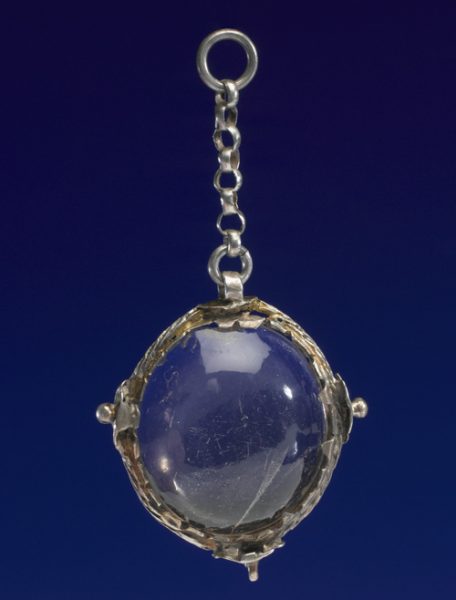
A shewstone which Dee bequeathed to his son Arthur
Dee, who had been living in London before his travels of 1562–4, now settled at Mortlake in Surrey, only a short distance from the royal residence at Richmond. He was there by September 1566, by which time he was probably already married. The substantial buildings he acquired enabled him both to assemble his extensive and still growing library and to commence the practice of alchemy. Both required financial resources, and he was constantly soliciting preferment, notably the provostship of Eton College. None of these attempts was successful—he made it clear that he did not wish to have a cure of souls—though he was granted dispensations by archbishops Parker and Grindal to hold his two rectories. There is no record that he resided at either, though a now vanished inscription once recorded his presence at Long Leadenham.
The Mortlake period, 1565–1583
The period from his settling in Mortlake about 1565 to his departure for Poland in 1583 was the most prosperous and productive of Dee’s life, and the various strands of his activity are intertwined with some complexity. Mathematics remained his most visible interest, though his teaching of the subject must have been interrupted by his continental journey of 1562–4, and the move to Mortlake no doubt entailed the residence there of his students. The first of many editions by Dee (sixteen survive up to 1607) of Robert Recorde’s Ground of Arts was published in 1561, though the fact that he lists no copy in his own library suggests that he regarded it as an elementary textbook. His pupil Christopher Carye died in 1563 or 1564, and the only other early recorded pupil is Thomas Digges, to whom he passed a copy of Archimedes in 1559.
The most influential of all Dee’s published works was his ‘Mathematicall praeface’ to Henry Billingsley’s English translation of Euclid, Elements of Geometrie, printed by John Daye in 1570. The preface is firstly a long encomium of the study of ‘thynges mathematicall’ as partaking both of the supernatural and of the natural, and of geometry in particular. He goes on to enumerate the practical arts (proper to ‘mechanicians’) which derive from mathematics, and under one of the last of these, ‘thaumaturgike’, exculpates himself with some passion from the charge of conjuring. He also defends the use of the vernacular, as not encroaching on the rights of the universities. His concept of ‘Archemastrie’, which ‘procedeth by Experiences’ (J. Dee, Mathematicall praeface, H. Billingsley, Elements of Geometrie, 1570), has been seen by some as foreshadowing the experimental science of the next century, but he also hints at magical interests and practices under this very heading. In general the ‘Praeface’ is now seen as a retrospective view of his own practice and teaching after his return to England in 1551, but the interest in magic, and possibly in skrying (seeing, or conversing with, spirits), may be a development of the late 1560s.
As a result of his move to Mortlake Dee had more space for the practice of alchemy, and in 1571 he travelled into the duchy of Lorraine to furnish his laboratories (he had three by 1583), bringing back a great cartload of specially made vessels. An inscription in a book shows that he was also in Paris on 31 May. He fell seriously ill on his return, and later recorded it as a mark of royal favour that the queen sent to him two of her physicians, Dr Apsloo (Edward Atslowe) and Mr Balthrop. In November 1572 a supernova appeared in the constellation of Cassiopeia. Dee seems to have concluded that the ‘blazing star’ was located in the region of the fixed stars, where Aristotelian doctrine taught that nothing might change. The event occasioned many treatises, among them Thomas Digges’s Alae seu scalae mathematicae of 1573, and Dee’s own Parallaticae commentationis praxeosque nucleus quidam. The two tracts refer to one another, and often survive bound together. Nevertheless, as an inscription in his copy of Manilius’s Astronomica shows, the event portended for him the finding of a great treasure or of the philosopher’s stone, and quests for gold and silver, whether deliberately buried, to be mined or created by projection, underlay much of his involvement in discovery in the New World, in alchemical pursuits, and ultimately in the ‘angelic conversations’ with Edward Kelley from 1582. Dee also had, according to his Diary, some rights in mining for silver in Devon. His astronomical skills were invoked in reassuring the court about the comet which appeared in 1577, and, more terrestrially, in calming fears about an image of the queen with a pin stuck in its breast, found in Lincoln’s Inn Fields.
Enquiries into ‘British’ history
Dee had taken little part in the programme initiated by Archbishop Matthew Parker for the recovery of early English, and particularly Anglo-Saxon, manuscripts. He owned, and often annotated, copies of most of the antiquarian books that resulted from this movement, though with one possible exception, he had no Anglo-Saxon manuscript, and no copy of the Anglo-Saxon gospels printed in 1571. The annotations show that his antiquarian interests were strong, and moreover that he was developing an interest in British (that is Welsh) antiquities, and that this interest was stimulated by an awareness, well documented in his pedigrees, of his Welsh ancestry. In 1574 he undertook a tour of the marches from Chester to Hereford, which also took in some places in eastern Wales. His quest was for ‘monuments’, a term which embraced both antiquities and manuscripts. He saw some of the latter in the hands of Welsh owners, and may have copied some then, and acquired a few from the family of Sir John Prise (to whom he believed himself related) in Hereford. Some documents were rescued from a decayed chapel at Wigmore.
Like Prise, Dee was a firm believer in the historicity of the ‘British history’ deriving from Geoffrey of Monmouth, and owned several Brut chronicles in English and Welsh (a language of which he had some reading knowledge and in which he owned several printed books). Arthur (after whom he named his first son) is a frequent subject of annotation in his books and manuscripts. He embroidered upon the British history, adding further realms to King Arthur’s conquests, and also interested himself in the story of the voyage of Madog ab Owain Gwynedd to North America, and some of his notes show him seeking evidence for an early ‘British’ presence in the New World. From these dubious sources he derived not only his own role as a British gentleman, philosopher, and navigator, but also the titles of Queen Elizabeth to large parts of North America.
Navigation and discovery
Although Dee claimed, no doubt with justification, early acquaintance with navigators such as Richard and Nicholas Chancellor and Stephen and William Borough who were initiating trade with Russia and seeking a north-east passage to Cathay, precise evidence for his involvement is lacking. From about 1570, however, he emerges, both in manuscript and print, as the advocate of a policy for strengthening England politically and economically, and for imperial expansion into the New World. The first survivor of these manuscript tracts, Brytannicae reipublicae synopsis (1570), perhaps a schematic digest of a larger work requested by Dee’s friend and patron Edward Dyer, concerns itself with trade, ethics, and national strength. Six years later he began a much more ambitious project, The Brytish Monarchy, of which only the first part, General and Rare Memorials Pertaining to the Perfect Art of Navigation (1577), achieved print, albeit in a limited edition. Another volume of great bulk was to consist of Queen Elizabeth’s Tables Gubernautik, but has not survived; a third volume was destroyed, perhaps by its author, while a fourth, Of Famous and Rich Discoveries, remains only in Dee’s now very imperfect manuscript. Concurrently with these writings Dee was producing another work, the Brytanici imperii limites of 1576–8 (extant only in a manuscript by another hand).
Dee was the first to use the term ‘British Impire’ (in the General and Rare Memorials in English). The Limites formed the basis of his 1577 declaration to the queen of her rights in the northern realms, based upon his reconstruction of Arthur’s conquests (and in the next year, in a meeting with Daniel Rogers, the conquests of King Malgo were added to the imperial precedents). These rights were further set out in two great rolls presented to the queen and Burghley in October 1580.
English expansion into the New World was supported by a range of motives, including a crudely economic greed for the gold which the Spanish and Portuguese had seized in southern America, and by the desire, both political and religious, to weaken those states. Dee’s contribution was not only that of his writings, though the precedent of ‘British’ conquest was powerful. He also acted as an adviser on navigation to the three voyages of Martin Frobisher in 1576–7, evidently had a financial interest in them, and took some part in the assaying of the ore which Frobisher brought back in the mistaken belief that it was gold.
In the following decade the pace of maritime discovery quickened and there were further calls upon Dee’s navigational knowledge. The search for a north-east passage was renewed, and he was among those present at Muscovy House on 17 May 1580 when the intended voyage of Arthur Pet and Charles Jackman was discussed. He provided them with instructions. He was also consulted in July 1582 by Sir George Peckham about the title to Norombega, as the American Indians termed the area roughly covered by Massachusetts and Maine. Peckham had devised a scheme for settling English Catholics in North America, and was naturally concerned about the rights already conferred by the pope upon Spain and Portugal. Dee, assuring Peckham of the priority of Madog’s voyage, was promised a generous estate in this new conquest. There was a further meeting with Peckham’s men, Clement and David Ingram, in October, but the scheme came to nothing.
More significant than either of these ventures was the initiation of another attempt to discover a north-west passage, with a visit on 23 January 1583 by Sir Francis Walsingham to Dee’s house, where Adrian Gilbert, Sir Humphrey Gilbert’s younger brother, was already present. The discussions continued on the following day at Robert Beale’s house, and now involved John Davys, whom Dee had known since 1579 (and perhaps earlier), and who is thought to have owed much of his theoretical knowledge of navigation to Dee. Adrian Gilbert, Davys, and Dee were subsequently linked in a proposed ‘Fellowshippe of New Navigations, Atlanticall and Septentrionall’, but in a later draft of the proposal Dee’s name was dropped in favour of that of Walter Ralegh.
During this same period Dee was also involved in the debate over the calendar. By the bull Inter gravissimas of 24 February 1582, Pope Gregory XIII introduced the reform of the calendar, the main effect of which was the loss of ten days. Dee was consulted, and delivered to Burghley on 26 February 1583 his Playne discourse … as concerning the needful reformation of the vulgar kalender for the civile yeres and daies accompting. He recommended the excision of eleven rather than ten days. Harmonization with the Gregorian system was acceptable to him and to the secular authorities, but opposition from Archbishop Grindal and other bishops ensured that England retained the Julian reckoning until 1752.
‘Angelic conversations’, and journey to Poland
Dee had given some hints about magical practice in the ‘Mathematicall praeface’ of 1570, and these have been plausibly interpreted as ‘divination by mirrors, crystals, gems, and other reflecting surfaces’ (Clulee, 169). He possessed a number of such objects, such as the distorting mirror (inherited from Sir William Pickering) in which Queen Elizabeth viewed herself in 1575, and the black obsidian mirror and the crystal ball now in the British Museum. Since he was himself unable to see anything in these—except on 25 May 1581 when ‘I had sight in Chrystallō offerd me, and I sawe’—he employed a series of mediums. Although previous attempts had probably been made, the first recorded session was with Barnabas Saul on 22 December 1581; however, Saul was discredited by March 1582, and was supplanted by ‘Mr Talbot’, as Dee first knew Edward Kelley.
Dee had seen the nova of 1572 as the augury of some great revelation, and this was realized for him on 10 March 1582, when sessions with Kelley as medium began. The records of the sessions, which ran from May 1583 to May 1587, with some later sessions also recorded, were published in 1659, long after Dee’s death, by Meric Casaubon as A True & Faithful Relation of what Passed for Many Yeers between Dr. John Dee and some Spirits. Attempts have been made to interpret these writings as the practice of cabbala or even as confidential diplomatic messages. The sessions evidently began with prayer and petitions, and the participants then waited until the medium could see something in the stone; it seems safest to regard them as exercises in crystallomancy. Dee usually records in full the prayer, in Latin or English, with which the action closed.
The ultimate significance of these conversations is of two men linked in mutual dependence on forms of self-deceit: the one, Dee, was led by his own learning to a belief in the possibility of intercourse with a benevolent supernatural world and in the transmutation of baser metals into gold; the other, Kelley, drew upon Dee’s learning and substance to feed, perhaps in all sincerity, what must ultimately be judged to be a delusion. As a private record the True & Faithful Relation contains not only details of the sessions, but biographical notes supplanting those in the two series of ephemerides, from the time of Dee’s departure for Poland to the parting from Kelley. The existence of the sessions must indeed have been known to Dee’s contemporaries, since others than he and Kelley were involved, and the angels were at first questioned about the north-west passage, and on 26 March on Adrian Gilbert’s task of converting the heathen. When Albrecht Łaski, palatine of Sieradż in Poland, arrived in England and established close relations with Dee, he was admitted to the sessions and occasionally took part in them during the journey to Poland and afterwards.
It is probable that Łaski knew of Dee’s fame as an alchemist through Philip Sidney, and that acquaintance with Dee was his principal motive in travelling to England. Łaski arrived on 1 May 1583, and Dee met him on 13 May in Leicester’s chambers at Greenwich, and again at Mortlake on 18 May. Łaski returned in greater state to Mortlake in the queen’s barge and in the company of Sidney, Lord Russell, and others on 15 June. His acquaintance with Dee was thus being fostered by the more aggressively protestant party at court, which may have seen in Łaski, enriched by alchemical practice and reconverted to protestantism, a counterweight to Catholic and Habsburg power in Europe. Dee’s entertainment of Łaski was subsidized by the queen, and his departure with him was no doubt facilitated. The preoccupation with Łaski and with angelic conversations drew Dee away from the planning of the north-west voyage, and the anger that this occasioned among his associates probably lay behind the raid upon his house and library after his departure for Poland. He made over his house to his brother-in-law Nicholas Fromonds, and had his library catalogued (making two fair copies of the catalogue himself) by 6 September. He selected about 800 of his books for the journey.
The party which left Mortlake on 21 September 1583 consisted of Dee, his wife, their three children, Edward Kelley and his wife, Joan, and his stepchildren, and a retinue of servants. Although Dee took with him his copy of Stadius’s Ephemerides (one of the two sources of the Diary), he made no entries in it until November 1590, some time after his return to England, and evidence for his movements has to be disentangled from the record of ‘actions’ (as the angelic conversations are normally termed) in the True & Faithful Relation. He acquired Maginus’s Ephemerides, perhaps at the Leipzig fair in 1586; this volume is heavily annotated from September 1586, while the True & Faithful Relation provides no biographical information after May 1587.
The party’s crossing to the Dutch coast and beyond was hazardous, and once on land its progress in winter was painfully slow. Dee and his family did not reach Łask (near Sieradż) until February 1584. Actions were held (sometimes involving Łaski) on shipboard and at various north German and Polish towns through which Dee and Kelley passed. There were actions at Łask, and many at Cracow, to which Dee and his family moved in March 1584. There he took a house for a year; this probably completed the period of a year and eight months for which he had originally intended to be absent from England, but if his plans had also included the practice of alchemy, nothing of this appears in the actions. Łaski had meanwhile left for Kesmark in Slovakia and seems largely to have lost interest in his guests, though contact and perhaps even payments seem to have been maintained, and Dee records that ‘A. L.’ (presumably Łaski) was briefly at Třeboň at the end of 1588.
Dee and Kelley, having received angelic bidding to go to the emperor Rudolf, set out for Prague, which they reached on 9 August 1584. Dee wrote to the emperor by Guillermo de San Clemente, the Spanish ambassador, and obtained an hour’s audience with Rudolf on 3 September—the only meeting between the two men. Meanwhile Dee received letters from England, dispatched in April, from which he learned of the disasters which had befallen his house and library. The audience with Rudolf had little result, and Dee’s contact thereafter was with one of the emperor’s counsellors, Jakob Kurtz, though San Clemente proved hospitable, and later acted as godfather to one of Dee’s children, Michael. The angel Uriel then instructed Dee to write to the emperor saying he could make the philosopher’s stone.
In April 1585 Dee and Kelley (and their families) returned to Cracow and Łaski obtained for Dee audiences with King Stefan Batory. On returning to Prague, Dee and Kelley resumed their angelic conversations, admitting to them Francesco Pucci, a renegade (though ultimately conforming) Catholic. In May 1586 Dee met the Bohemian nobleman Vilém Rožmberk, and at this point Dee’s concern with alchemy seems to have revived, and he made a journey to ‘Valkenaw glasse-house’ and to Leipzig mart. From there he wrote a letter to Walsingham complaining that he had had no answers to his earlier letters, and asking for justice for his house, library, goods, and revenues. Dee and Kelley were banished from the emperor’s domains at the instance of the papal nuncio on 29 May, but Rožmberk obtained permission for them to remain on his estates at Třeboň, where, after a confused journey to Erfurt and Kassel, Dee, Kelley, and their families arrived in September 1586.
In December Dee received through Edward Garland an offer of employment from the tsar of Russia. He nevertheless remained with Rožmberk, devoting more time to alchemy, though Kelley increasingly dominated the practice, and even produced what passed for gold. The actions were also resumed, and Dee attempted to ‘translate’ Kelley’s office to his seven-year-old son Arthur. The final recorded actions were in April 1587, during which Kelley received from the spirit Madimi the doctrine that he, Dee, and their wives should hold all things in common. ‘It was agreed by us to move the question, whether the sense were of Carnal use (contrary to the law of the Commandment) or of Spiritual love’. The covenant of cross-matching was drawn up and acted upon. Theodore Dee (the name may be significant) was born on 28 February 1588. Although Rožmberk’s patronage ensured that the Dees lived in comfort and security at Třeboň, he wrote to Queen Elizabeth in November 1588 to announce the return of himself and Kelley to England. But Kelley did not return, and Dee made over to him his alchemical materials. For Dee the break was not final; he received letters from Kelley, and continued to hope that he too would return. They parted in February 1589, and Dee left Třeboň at the beginning of a long and occasionally dangerous journey through central Europe to land in England on 23 November 1589.
Dee’s library
The building up of a large library was a theme that ran through Dee’s whole career, and the subject matter of the books in it—insofar as their acquisition can be dated—reflects the themes that preoccupied him throughout his life. At its greatest extent, when the catalogue was compiled immediately before his departure in 1583 for Poland and Bohemia, it was one of the greatest private libraries of sixteenth-century England, rivalled only by those of Andrew Perne and John, Lord Lumley, and it far exceeded in size the libraries in the universities and colleges of Oxford and Cambridge, and such ecclesiastical libraries as had survived the Reformation. There is, however, little evidence for Dee’s acquisition of books in the last twenty-five years of his life, and it is also probable that even the 1583 catalogue does not fully record the extent of his collections, particularly of manuscripts.

Dees drawing of the Sigillum Aemeth Sloane MSS 3188 (1582)
Dee began to buy books as an undergraduate, and the frequency of the annotations in some of the Latin classical authors which can be attributed to his Cambridge days attest the systematic care with which he read them. The nature of his annotations has in itself been a subject of study; they have been compared to a dialogue between the reader and the text before him. The notes most frequently take the form of underlinings, or of repetition of the words which particularly interested him. These are usually written very neatly in varieties of the elegant italic hand which he developed at Cambridge. Some of the most significant notes, either in the text or on flyleaves, are autobiographical, and are sometimes, to use W. H. Sherman’s word, validated with Dee’s initials, or with the Greek delta which he used to signify himself. A number of books are recorded in the catalogue in multiple copies, and it has been suggested that, like some university tutors of the time, Dee maintained additional copies for the use of his pupils. A note of exceptional importance records that the book was read in Edmund Bonner’s household, and confirms the close association with the bishop which is apparent from a hostile source, the earlier editions of Foxe’s Acts and Monuments.
Although it was possible to find a wide range of scholarly books in the stock of the Cambridge stationers, the greater range and number of books Dee was able to acquire in Louvain, Antwerp, and Paris is very apparent from the survivors from the years 1548 to 1551. The income he derived from the patronage of Cheke and of Edward VI, and from his aristocratic employers, facilitated the flow of books into his library, until this was halted by the disasters of the Dudleys and his own imprisonment. The introduction to Bonner’s household may or may not represent a sincere move to the Catholic position, but the Supplication to Queen Mary of 1556 reveals a view common to Catholics and to many protestants, particularly later ones, that the dispersal of the monastic libraries had been a tragedy for learning and a national disgrace. The views that Dee expressed informed the building of his own library for the rest of his life. Most of the recommendations made in the Supplication for a royal or national library relate to the rescue, borrowing, and copying of manuscripts from the monasteries, but Dee also envisaged the copying of books in foreign libraries, and the acquisition of large numbers of printed books. In these aims he enjoyed the support of Bonner, but the death of Queen Mary in 1558 and the ejection of Bonner from his see diverted Dee’s energy from a national library into the creation of his own, while the books borrowed, sometimes upon Bonner’s security, were not returned. A hastily compiled and possibly incomplete list of his library can also be dated to his time in Bonner’s household.
Dee’s European travels of 1562–4 ranged more widely than his earlier journeys, and the sources of his books, often the best evidence for his movements, span from Antwerp to Venice; he seems to have employed a copyist in Rome. The dates of publication of his Hebrew books are clustered in these years. Though they survive in relatively large numbers, they are sparsely annotated, which suggests that Dee was not a fluent Hebraist. Although he discussed Paracelsus with Conrad Gesner in 1563, his huge Paracelsian collection seems to be of later date.
For his journey to Poland Dee packed about 800 of his books, and entrusted the care of those remaining at Mortlake to his wife’s brother. Within months of his departure the house was raided and many of his books and instruments were stolen or damaged. The culprits can be identified as former associates of Dee—John Davys the navigator and Nicholas Saunder (perhaps a former pupil)—impelled perhaps by Dee’s defection from the planning for the north-west passage. It is possible that Adrian Gilbert and Thomas Harriot also received books or instruments. There is no firm evidence for Dee’s acquisition of books during his six years of travel in continental Europe. On his return in 1589 he was able, after a dispute, to recover his house and books from Fromonds, and regained some books from Davys, though not from Saunder. During his later years at Mortlake and Manchester there is little evidence for addition to the library, but more for losses, loans, and even sales to alleviate his growing poverty. At some time before his death he seems to have made over his books to John Pontois (1565–1624), a merchant whom he had perhaps met in northern Europe, who retained them until his own death, though both Sir Robert Cotton and John Selden benefited from Pontois’s generosity by gift or loan. Since John Woodall and Dee’s servant Patrick Saunders were Pontois’s heirs, they must have been responsible for the final dispersal of Dee’s belongings in 1626 or 1627.
Dee claimed in 1592 that he had owned three thousand books and a thousand manuscripts. The catalogue of 1583, compiled by Andreas Fremonsheim, factor to Birkmanns of Cologne, records a smaller total, though it is possible that in the haste of departure Dee or Fremonsheim under-recorded the collections, particularly those of manuscripts. Though the library is now widely dispersed, the interests of antiquaries, notably Cotton and Brian Twyne, are responsible for the substantial holdings of manuscripts once owned by Dee now in the British Library and the library of Corpus Christi College, Oxford. The largest single accumulation of his printed books is in the library of the Royal College of Physicians; it derives ultimately from the depredations of Nicholas Saunders in 1583.
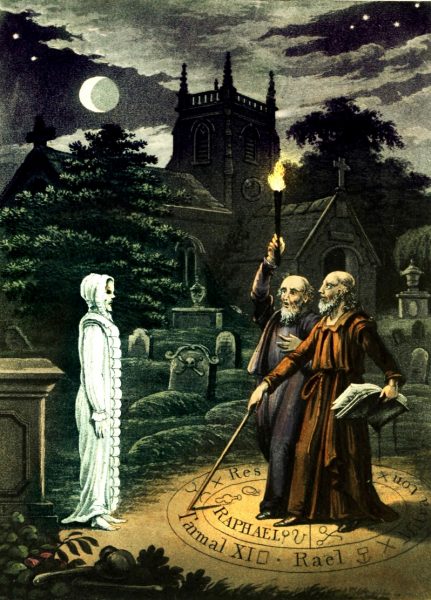
Dees associate in the Enochian conferences Edward Kelley,
raising a spirit with the assistance of Peter Waring
from ‘The Astrologer of the Nineteenth Century’
Later years and death
The five years after Dee’s return from Poland in 1589 were spent in attempts to recover his losses and to obtain a place that would provide for the needs of his large and growing household. (Madimi Newton Dee was born in 1590, Frances in 1592, and Margaret in 1595; Michael, however, died in 1594.) He came to an agreement with Nicholas Fromonds about the reoccupation of his house, united the books he had taken abroad with those which still remained at Mortlake, and recovered some of his missing volumes. By a legal oversight he had lost the income from his two rectories, and accordingly petitioned the queen for relief. The ‘Compendious rehearsal’ laid before the commissioners, Sir Thomas Gorges and Sir John Wolley, on 22 November (and previously before the queen by the countess of Warwick on 9 November) is the most reliable and comprehensive account of his life and works (eight printed and thirty-six in manuscript), and it was updated in 1594. It brought some financial relief from the queen but little redress, and Dee relied for a livelihood on these grants, on loans, and on fees from students. The quest for preferment recommenced, and Dee had hopes of the mastership of St Cross at Winchester, the chancellorship of St Paul’s, and, as in 1564, the deanery of Gloucester.
In May 1595 Dee obtained the wardenship of the collegiate church at Manchester, and took up the office in February 1596. He did not, however relinquish his Mortlake house, and seems to have left many of his books there, perhaps under the care of one Bartholomew Hickman, who had been sent to Dee in 1579 by Sir Christopher Hatton. The affairs of the college were in some disorder, and attempts to resolve them caused conflict with the fellows, notably with Oliver Carter, whose conduct was a frequent source of complaint in the Diary and in Dee’s letters.
Dee was visited by Christopher Saxton in 1596, and in May 1597 conducted a survey of the parish of Manchester. In the latter year Dee gave advice in the case of ‘demonic possession’ known as the ‘Seven in Lancashire’, lending books to the justice involved. This is also the year of the last of Dee’s political and maritime tracts, the Thalattokratia Brettanikē, a treatise on the sea-limits of the British empire written in response to a request in September by Sir Edward Dyer. Dee and his family were hard-pressed for money, and perhaps for food also during the famines of the 1590s. Help came in the form of cattle from Dee’s Welsh cousins, and in barrels of rye from Pontois, who was to become his final support and his heir. There are no entries in the Diary between March 1598 and 18 June 1600; Dee was probably in London, busied about the affairs of the college, since he was able on his return to show the fellows ‘the most part of the things that I had browght to pass at London for the College good’ (Private Diary). He also visited the grammar school on 5 August 1590, finding ‘great imperfections’ in the scholars. Since the entries cease altogether on 6 April 1601, few details of Dee’s later life are known, but the mention of Roger Cook suggests that his old assistant had set up alchemical practice at Manchester.
Dee’s poverty was certainly deepening, since he was forced to borrow money from Edmund Chetham in Manchester, and books and manuscripts seem to have been passing into and out of the earl of Northumberland’s library at Sion, apparently by the agency of Dee’s servant Patrick Saunders. He was presumably also in London for the printing by Peter Short of ‘A Letter Containing a most Briefe Discourse Apologeticall’, an expanded version of the sixth chapter of the ‘Compendious rehearsal’ of 1592–4 (in which the list of manuscript works has grown to forty-eight), but addressed to the archbishop of Canterbury. (This tract was reprinted by Short’s widow in 1603 as A Letter, Nine Yeeres since, Written and First Published.)
After the accession of James I, Dee claims to have become the new king’s ‘sworne servant’ on 9 August 1603, but was nevertheless alarmed by his published opinions on witchcraft. The tract addressed to the archbishop is usually found with a printed petition to the king, and a verse address to the Commons (both dated June 1604) protesting passionately against the slanderous epithet of ‘conjurer’, and calling for a special act to restrain the slander. Where Dee was at this time is unclear, but his family must have remained in Manchester, since his wife, Jane Dee, died of the plague and was buried there on 23 March 1605. The younger children, and perhaps an older son, Rowland, who had been baptized in 1583, must have perished then, since nothing is known of them thereafter.
Probably some time after 1605, Dee returned to Mortlake with his surviving daughter, Katherine (Arthur had married in 1602), and resumed the angelic actions with Bartholomew Hickman as skryer. An action appended to the True & Faithful Relation is dated 9 July 1607, and reveals that he was contemplating another foreign journey, and that he intended, or perhaps had been persuaded, to make Pontois his heir. Dee is traditionally said to have died at Mortlake in December 1608, but Pontois, who inherited Maginus’s Ephemerides with the other books, noted against the date 26 March 1609 a death’s head and ‘Jno Δ hor.3.a.m.’. This is confirmed by a note of Anthony Wood to Ashmole that Dee had died in Bishopsgate Street, where Pontois lived. 1609 is also the date given in a letter from Arthur Dee. Neither Pontois nor another informant of Ashmole, John Aubrey, could find a will, but Aubrey was shown the site of Dee’s grave in Mortlake church.


